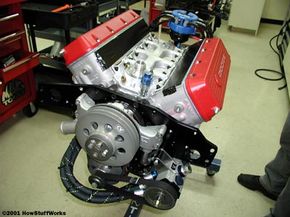The Engine
The engine in the NASCAR race car is probably the most crucial component. It has to make huge amounts of power for hours on end, without any failures.
You might think that these NASCAR engines have nothing in common with the engine in your car. What we learned was a little surprising: These engines actually share many features with street-car engines.
Advertisement
Dodge provides the engine block and cylinder head for the engines used by Bill Davis Racing. They are based on a 340-cubic-inch (5.57-liter) V-8 engine design that was produced in the 1960s.
The actual engine blocks and heads are not made from the original tooling. They are custom-made race-engine blocks, but they do have some things in common with the original engines. They have the same cylinder bore centerlines, the same number of cylinders and they start out at the same size (they get a little bigger during the building process). Like the original 1960s engines, the valves are driven by pushrods (see this page for information on the different types of valve arrangements).
The engines in today's NASCAR race cars produce upward of 750 horsepower, and they do it without turbochargers, superchargers or particularly exotic components. How do they make all that power?
Here are some of the factors:
- The engine is large -- 358 cubic inches (5.87 L). Not many street-cars have engines this big, and the ones that do usually generate well over 300 hp.
- NASCAR engines have extremely radical cam profiles that open the intake valves much earlier and keep them open longer than in streetcar engines. This allows more air to be packed into the cylinders, especially at high speeds (see How Camshafts Work for more details).
- The intake and exhaust are tuned and tested to provide a boost at certain engine speeds. They are also designed to have very low restriction -- that is, to provide little resistance to the gases flowing down the pipe. There are no mufflers or catalytic converters to slow the exhaust down, either.
- They have carburetors that can let in huge volumes of air and fuel -- there are no fuel injectors on these engines.
- They have high-intensity, programmable ignition systems that allow the spark timing to be customized to provide the most possible power.
- All of the subsystems, like coolant pumps, oil pumps, steering pumps and alternators, are designed to run at sustained high speeds and temperatures.
When these engines are machined and assembled, very tight tolerances are used (parts are made more accurately) so that everything fits perfectly. When an engine (or any part, for that matter) is designed, the intended dimensions of the part are given along with the allowable error in those dimensions. Making the allowable error small -- tightening the tolerances -- helps the engine achieve its maximum potential power and also helps reduce wear. If parts are too big or too small, power can be lost due to extra friction or to pressure leakage through bigger than necessary gaps.
Several tests and inspections are run on the engine after it is assembled:
- It is run on the dynamometer (which measures engine power output) for 30 minutes to break it in. The engine is then inspected. The filters are checked for excess metal shavings to make sure no abnormal wear has taken place.
- If it passes that test, it goes back on the dynamometer for another two hours. During this test, the ignition timing is dialed in to maximize power, and the engine is cycled through various speed and power ranges.
- After this test, the engine is inspected thoroughly. The valve train is pulled and the camshaft and valve lifters are inspected. The insides of the cylinders are examined for abnormal wear. The cylinders are pressurized and the rate of leakdown is measured to see how well the pistons and seals hold the pressure. All of the lines and hoses are checked.
Only after all of these tests and inspections are finished is the engine ready to go to the races. Insuring the reliability of the engine is critical -- almost any engine failure during a race eliminates the chance of winning.
